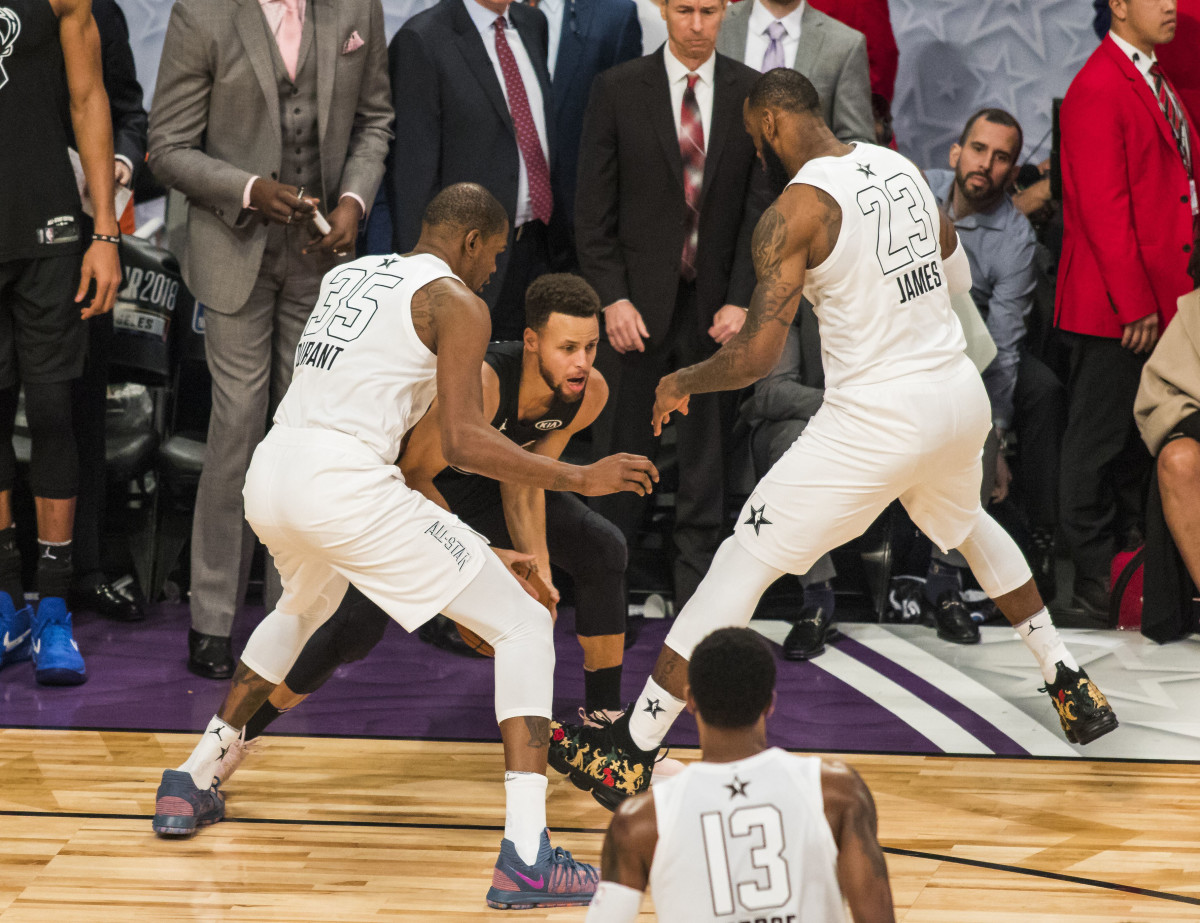Basketball's Best Players Fixed the NBA All-Star Game by Deciding to Compete Again

LOS ANGELES — Months of pomp, circumstance and shouty debates preceded this year’s NBA All-Star Game, thanks to a history-altering new captains format and the strange decision to protect feelings by not televising the draft of the rosters. But all of the NBA’s planning and all of the media’s hand-wringing were still contingent upon a simple premise: The players need to play hard or the showcase is doomed to fail.
Team LeBron’s thrilling 148–145 comeback victory over Team Stephen at Staples Center on Sunday proved that a little effort can go an awfully long way, even in a meaningless midseason exhibition. LeBron James claimed his third career All-Star Game MVP with a captivating closing stretch, finishing a beautiful series of passes with a tough lay-up, stepping back to drain a three-pointer over Joel Embiid, and then teaming with Kevin Durant to smother Stephen Curry on the game’s final possession.
NBA All-Star Game Takeaways: New Format Works and LeBron Still Reigns
This was the type of late-fourth-quarter intensity that fans and media alike salivate over, the type that the All-Star Game hasn’t produced in years, the type that raises and immediately answers everyone’s favorite barbershop questions. Who will rise to the occasion when the league’s best players are going all-out? Who is willing to accept the pressure—for better or worse—in big moments? Who wanted nothing to do with the ball when the game is on the line? Which youngster is ready to deliver an “I’m ready for primetime against the league’s A-listers” breakthrough?
Each of those queries generated answers on Sunday. James and Durant, who had promised to set the tone as the game’s “two best players” in an Uninterrupted interview released earlier in the week, brought home the win with a four-armed last stand. Curry and teammate James Harden both actively sought to play hero, only to come up short. By contrast, DeMar DeRozan withered down the stretch with a missed free throw and a turnover. And then there was first-time All-Star Joel Embiid, who nearly spoiled James’s big comeback with forceful offensive play and timely rim protection.
Sunday’s game was far from perfect given its sloppy start and lulls in the action, but the defensive intensity was miles better than the 2016 and 2017 All-Star Games.
“Coaches, AAU coaches, high school coaches, coaches in Italy, are all looking at our [All-Star Game] and saying … [it’s like the] Harlem Globetrotters,” said Team LeBron coach Dwane Casey. “That's not a good description for our great game because we've got too many great coaches, too many great players, developmental coaches, and we put too much time and effort to lose the image that we've built up.”

Two years ago, the West and East combined for a record 369 points. In 2017, the two teams topped that with another record—374 points—in a game that featured less defensive pushback than a summer league run. Those games were unwatchable and a waste of everyone’s time.
“We wanted to change the narrative of the All-Star Game being a joke,” Durant said. “Today we wanted to make it a real basketball game.”
The contest was a real, riveting basketball game when it mattered, with James (29 points, 10 rebounds, 8 assists) dictating the late-game action, Embiid (19 points, 8 rebounds) emerging as a fascinating match-up wildcard, and video reviews adding a layer of controversy on top of the high-level play. Once the dust settled, Team LeBron and Team Stephen combined to score “only” 293 points, the lowest All-Star Game total in five years and a 22% drop from 2017.
2018 NBA All-Star Game is lowest scoring (293 combined points) since 2013, down 81 points from last year's record. Also, closest margin (3 points) since 2012. pic.twitter.com/BpLrqBE1T7
— Ben Golliver (@BenGolliver) February 19, 2018
Substantially lower scores, yes. But a far more compelling result. Order, sanity and respectability were restored.
“[Changing the format] worked out not only for the players, not only for the league, but for our fans, for everybody,” James said. “It was a great weekend, and we capped it off the right way.”
What, exactly, prompted this year’s turnaround in effort and intensity? Was it, as Kyrie Irving suggested, the $350,000 in charity money that went to the winning team? Was it the more balanced rosters which saw James ditch his weak all-East supporting casts of recent years to add Durant, Russell Westbrook, Anthony Davis and Paul George from the West? Was it the addition of Embiid and his mouth-watering potential playoff preview? Was it merely guilt after the last two All-Star duds? Pride? Boredom?
A full analysis would credit NBA commissioner Adam Silver and National Basketball Players Association president Chris Paul for putting their heads together months ago to shake things up. More immediately, such an analysis would give a nod to Casey for setting the tone by throwing out some extra defensive traps and coverages. It would note that James’s comeback never would have been possible without the new roster format given the substantial contributions of his Western Conference teammates.
And it would specifically credit James—who spent Saturday discussing his symbolic value to society when it comes to conversations about race—for accepting the challenge of fixing a broken All-Star Game culture. If James had coasted through the fourth—or if he had simply shut down early—the entire endeavor looks a lot less rosy.
The All-Star Game conversation will surely turn in the coming days to further tweaks to the rosters and format, new calls for televising the drafts, and perhaps other proposed changes to the ballot and voting criteria. That’s all well and good, as long as the focus remains on the most important takeaway for future years: The best basketball players in the world fixed the NBA All-Star Game by deciding to compete again.
